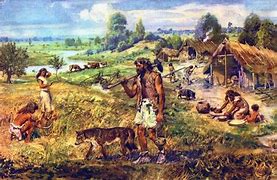Social organisation
During most of the Neolithic age, people lived in small tribes composed of multiple bands or lineages. There is Little scientific evidence of developoed social stratification in most Neolithic societes; social stratification is more associated with the later Bronze Age. Although some late Neolithic societes formed complex stratified shiefdoms similar to Polynesian societes, most Neolithic societes were relatively simple and egalitarian. However, Neolithic societes were noticeably more hierarchical tan the Paleolithic cultures that preceded them. The domestication of animals resulted in a dramatic increase in social inequality. Possession of livestock allowed competition between households and resulted in inherited inequalities of wealth. Neolithic pastoralists who controlled large herds gradually acquired more livestock, and this made economic inequalities more pronounced. However, evidence of social inequality is still disputed.
Families and households were still largely independent economically, and the household was probably the center of life. However, excavations in Central Europe have revealed that early Neolithic Linear Ceramic cultures were building large arrengements of circular ditches. These structures required considerable time and labour to construct, which suggests that some influential individuals were able to organise and direct human labour.
There is a large body of evidence for fortified settlements at Linearbandkeramik sites along the Rhine, as at least some villages were fortified for some time with a palisade and an outer ditch. Settlements with palisades and weapon-traumatized bones have been discovered. And war was probably more common during the Neolithic tan in the preciding period. This supplanted an earlier view of the Linear Pottery Culture as living a ''peaceful, unfortified lifestyle.''
Control of labour and inter-group conflicto is characteristic of corporate-level or 'tribal' groups, headed by a charismatic individual; whether a 'big man' or a proto-chief, functioning as a lineage-group head. Whether a non-hierarchical system of organization existed is debatable and there is no evidence that explicitly suggests that Neolithic societes functioned under any dominating class or individual, as was the case in the chiefdoms of the European Early Bronze Age.

Families and households were still largely independent economically, and the household was probably the center of life. However, excavations in Central Europe have revealed that early Neolithic Linear Ceramic cultures were building large arrengements of circular ditches. These structures required considerable time and labour to construct, which suggests that some influential individuals were able to organise and direct human labour.
There is a large body of evidence for fortified settlements at Linearbandkeramik sites along the Rhine, as at least some villages were fortified for some time with a palisade and an outer ditch. Settlements with palisades and weapon-traumatized bones have been discovered. And war was probably more common during the Neolithic tan in the preciding period. This supplanted an earlier view of the Linear Pottery Culture as living a ''peaceful, unfortified lifestyle.''
Control of labour and inter-group conflicto is characteristic of corporate-level or 'tribal' groups, headed by a charismatic individual; whether a 'big man' or a proto-chief, functioning as a lineage-group head. Whether a non-hierarchical system of organization existed is debatable and there is no evidence that explicitly suggests that Neolithic societes functioned under any dominating class or individual, as was the case in the chiefdoms of the European Early Bronze Age.
Comentaris
Publica un comentari a l'entrada